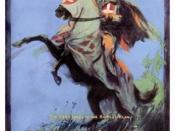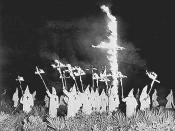The 1950s is often recalled as an era of conservative, consensual perfection, a "last fine time" before the upheavals of the 1960s, deindustrialization, and a new wave of immigrants set the nation on the road to decline and invisible lines separated its people (Graebner 336). Although most Americans were living a comfortable lifestyle due to the healthy economy, the 1950s should not have been considered to be a good time for all people because the feminist movement was at a standstill and the heightened racial tensions. Minorities living in industrial cities were living in impoverished conditions while middleclass white Americans drank deeply from the gilded goblet.
A great example of the growing gap that was emerging in both income and social classes is the superficial television program Leave It To Beaver. The popular television show often aimed toward a moral lesson and is oft looked to as an effective means in summing up the happy-go-lucky lifestyle that many nuclear families led.
The main character's father was well known for always having the solution to everything while the mother wanted nothing more than to tend to her loving family. This, in a sense, halted the feminist movement by depicting females as inferior housewives. This stereotypical portrayal of the suburban lifestyle often was echoed through housing developments nationwide, one example being the well-known Levittown, which sprung up during the early 1950s in order to accommodate the "White Flight" (Bailey 885).
In all regions, America's modern migrants - if they were white - fled from the cities to the suburbs. Suburbanization, in the postwar years, bloomed because people wanted to escape the crowds and noise of the city (Lassiter 182). In lieu of new vacancies, African Americans were quick to move into the urban slums mainly because housing was affordable and due to...


